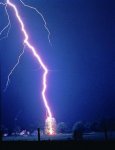...the mast should be bonded to a dedicated grounding rod using a minimum 10ga wire.
Yes doesn’t 10ga wire seem a little too skimpy? But then again this is not a system designed for a direct strike. This is a system that is designed to dissipate static caused by nearby strikes, wind, etc. I used 8 ga thhn and bonded it directly to the grounding rod. Apparently, and I am certainly no expert, when lightning strikes nearby there can be many leaders that attract themselves towards the main bolt, these leaders can originate from things that do not have the preferred ground as the direct bolt but have some path to ground. Again I am not an electrician or any kind of expert in this field.
...the grounding rod should be bonded to the house grounding system using 6ga copper wire.
Yes. I used 4 ga because my father in law had some left over from another project and IMHO this would be a place to not skimp.
...a shield ground should be used on the coax.
Yes, these do not have to be complex but remember NEC is minimum
Is this correct? The PolyPhaser would be above and beyond NEC, correct?
I believe that it would because the polyphasers that I have seen all have, and I believe they would need in order to work properly, a ground attachment lug. So essentially they are working like a coax ground shield but have the gas discharge tube as an extra measure. This is probably why they are so pricey and probably the way to go. They are in service at my station along with 1/2" heliax.... clean up drool...
You will notice on this picture below from
http://wsmweather.co.uk/wp-content/uploads/2010/05/lightning-strike-tree.jpg
The leader running from the antenna on this farm house towards the main bolt. I would not consider this a direct strike but, again IMHO, it is probably a lot of juice produced and hopefully the grounding that I described via NEC 800 would help..... but when a storm is approaching I just unplug even though my system is protected, at least to nec plus some additional "beef" in regards to wire gauge.
Remember lighting is, from what I can gather from reading many posts, looking at other websites like:
Antenna Grounding - Mike Holt's Forum
Mike Holt's Forum - Search Results
Recommended Grounding Guidelines - National Lightning Safety Institute
is unpredictable.
Personally If I had the resources I would put up a tower. Good Luck!


